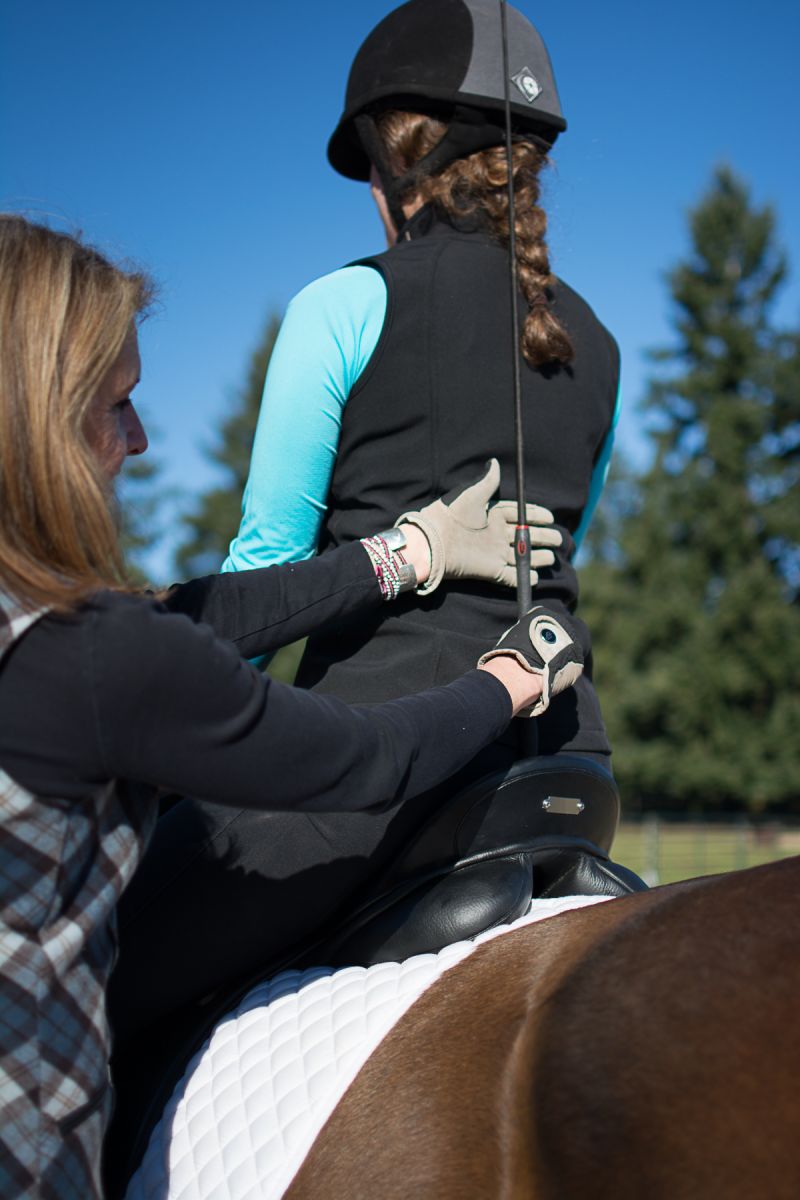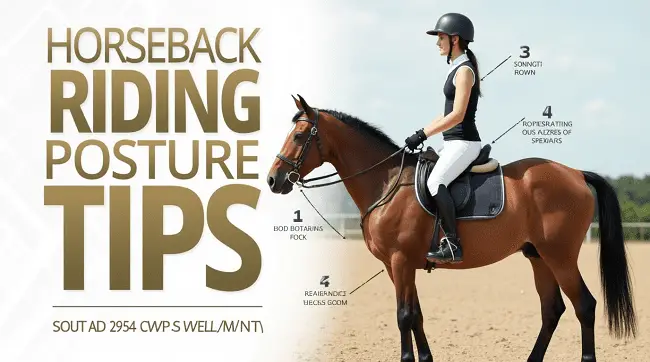Proper posture is vital for horseback riding. It ensures comfort and safety for both rider and horse.
Riding a horse requires balance, coordination, and a deep understanding of the animal’s movements. One key aspect of mastering horseback riding is maintaining the right posture. Good posture not only enhances your riding experience but also helps in communicating more effectively with your horse.
Whether you are a beginner or an experienced rider, understanding and practicing the correct posture can make a significant difference. In this guide, we’ll explore essential tips to help you improve your horseback riding posture, ensuring a more enjoyable and harmonious ride. Stay with us as we delve into these practical and easy-to-follow tips.

Credit: www.horsejournals.com
Importance Of Good Posture
Good posture is essential for safe and enjoyable horseback riding. It improves balance, communication with the horse, and reduces the risk of injury.
Good posture is vital in horseback riding. It affects both the rider and the horse. Proper posture helps distribute your weight evenly. This balance keeps you and your horse comfortable. It also prevents unnecessary strain on your horse.Enhancing Rider Comfort
Good posture improves rider comfort. Sitting upright reduces back pain. It allows the rider to move freely. Your body stays relaxed. You will enjoy longer rides without discomfort. Good posture also minimizes fatigue.Improving Communication With The Horse
Good posture improves communication with the horse. Horses respond to body signals. Clear signals come from a balanced rider. Your horse understands your commands better. This leads to a smoother ride. Trust builds between you and your horse.“`Basic Riding Position
Achieving the correct basic riding position is essential for every horseback rider. A good posture ensures comfort, safety, and effective communication with your horse. Focusing on the alignment of your spine and the position of your hands is crucial.
Alignment Of The Spine
Your spine should be straight but relaxed. Imagine a line running from your head to your tailbone. This line should be straight, without any slouching or arching. Keep your shoulders back and down. Avoid hunching forward. A straight spine helps you balance and maintain control.
Here are some tips for maintaining proper spine alignment:
- Keep your head up and eyes forward.
- Relax your shoulders.
- Sit tall and avoid leaning.
Following these tips will help you stay balanced and connected with your horse.
Position Of The Hands
Your hands play a key role in communicating with your horse. Hold the reins gently but firmly. Your elbows should be close to your body and form a straight line from your elbow to the horse’s mouth. This helps in maintaining a soft and steady contact with the reins.
Consider these points for the correct hand position:
- Keep your hands low and close together.
- Maintain a straight line from your elbow to the bit.
- Ensure your fingers are closed around the reins.
Proper hand position allows for better control and clearer communication with your horse.
Leg And Foot Placement
Leg and foot placement play a crucial role in horseback riding. Proper positioning ensures balance, control, and safety. Beginners and seasoned riders alike need to pay attention to these details. Let’s dive into some essential tips.
Proper Stirrup Length
Adjusting the stirrup length is key to maintaining a good posture. Your stirrups should be neither too long nor too short. When sitting in the saddle, the stirrup should hit just below your ankle bone. This allows for comfortable leg movement and better control of the horse.
To check your stirrup length, let your legs hang freely. The bottom of the stirrup should touch your ankle. Adjust accordingly if it’s too high or too low. This small adjustment can make a big difference in your riding experience.
Correct Foot Position
Proper foot placement in the stirrups ensures stability and control. Place the ball of your foot on the stirrup, not the arch. This provides a secure grip and allows for quick adjustments.
Keep your heels down and toes pointed forward. This position helps maintain balance and distributes weight evenly. Avoid pointing your toes outward or upward. It can cause instability and discomfort.
Pay attention to your foot position throughout your ride. Consistent practice will help develop muscle memory, making proper foot placement second nature.

Credit: www.youtube.com
Maintaining Balance
Maintaining balance is crucial for horseback riding. A rider must have good balance to control the horse effectively. Proper balance ensures a safe and enjoyable ride. Let’s discuss key points to help you maintain balance.
Center Of Gravity
Your center of gravity is the point where your body weight is balanced. When riding, keep your center of gravity low and aligned with the horse’s movement. Sit straight, but relaxed. Maintain an even weight distribution on both seat bones.
| Do | Don’t |
|---|---|
| Keep a straight posture | Lean too far forward or backward |
| Distribute weight evenly | Shift weight to one side |
Using Core Muscles
Strong core muscles are vital for balance while riding. Your core includes your abs, lower back, and pelvic muscles. Engage these muscles to stay steady. This helps you absorb the horse’s movements.
- Engage your abdominal muscles
- Keep your lower back straight
- Use your legs to grip the horse gently
Practice off-horse exercises to strengthen your core. Planks and sit-ups are good choices. A strong core gives you better control and improves your riding experience.
Common Posture Mistakes
Maintaining proper posture is crucial for an enjoyable horseback riding experience. Incorrect posture can lead to discomfort for both rider and horse. Let’s explore some common posture mistakes to avoid.
Slouching
Slouching is a frequent mistake among riders. It can affect your balance and control. Always sit up straight in the saddle. Keep your back aligned with your hips. This helps distribute your weight evenly. It also reduces strain on your horse’s back.
Tense Shoulders
Tense shoulders can create stiffness in your riding. Relax your shoulders to improve your flexibility. This allows smoother movements with your horse. Avoid hunching your shoulders up. Keep them down and relaxed. This helps maintain a natural and comfortable riding position.
Exercises To Improve Posture
Proper posture is essential for safe and enjoyable horseback riding. Improving your posture can help you maintain balance and control. Regular exercises can make a big difference. Below are some effective exercises to enhance your riding posture.
Stretching Routines
Stretching helps to increase flexibility and reduce muscle tension. Here are some simple routines:
- Cat-Cow Stretch: This yoga pose helps to stretch your back and neck.
- Hip Flexor Stretch: Stretching your hip flexors can improve balance.
- Shoulder Rolls: Rolling your shoulders forward and backward can reduce tension.
- Hamstring Stretch: This stretch helps to keep your legs flexible.
Do these stretches daily for the best results.
Strengthening Workouts
Strengthening exercises build the muscles needed for good posture. Consider adding the following workouts to your routine:
- Planks: Planks strengthen your core muscles, which are crucial for balance.
- Wall Sits: This exercise strengthens your legs and improves endurance.
- Leg Raises: These help to build strength in your lower body.
- Back Extensions: Strengthening your back muscles helps to maintain an upright posture.
Incorporate these exercises into your weekly routine to see improvements.
| Exercise | Target Area | Frequency |
|---|---|---|
| Cat-Cow Stretch | Back and Neck | Daily |
| Hip Flexor Stretch | Hips | Daily |
| Planks | Core | 3 times a week |
| Wall Sits | Legs | 3 times a week |
These exercises help improve strength and flexibility. Keeping your posture in check will make your horseback riding experience more enjoyable.
Advanced Posture Techniques
Advanced posture techniques can make a big difference in horseback riding. Proper posture improves balance and control. It also ensures the horse’s comfort. Let’s explore some advanced posture tips for different gaits and riding styles.
Adjusting For Different Gaits
Each gait requires a unique posture. At a walk, sit deep in the saddle. Keep your back straight and relaxed. Your hips should move with the horse’s stride.
In a trot, maintain a steady rhythm. Rise gently from the saddle with each stride. Keep your shoulders relaxed and your eyes forward.
At a canter, lean slightly forward. Engage your core muscles to stay balanced. Let your hips follow the horse’s motion. This helps maintain smooth and controlled movement.
Posture In Various Riding Styles
Different riding styles demand specific postures. In English riding, sit tall and keep your heels down. Your elbows should stay close to your sides. This aids in precise control of the reins.
Western riding requires a more relaxed posture. Sit deep in the saddle with your legs slightly forward. Keep a loose grip on the reins. This posture allows for better communication with the horse.
In dressage, posture is key for performance. Sit tall with a straight back. Keep your hands steady and close to the saddle. Your legs should maintain light contact with the horse’s sides.
Jumping requires a forward-leaning posture. As you approach a jump, rise slightly from the saddle. Keep your eyes focused on the landing spot. This helps prepare both you and the horse for a smooth jump.

Credit: horse-canada.com
Benefits Of Professional Lessons
Horseback riding is a rewarding activity that requires proper technique and posture. Professional lessons offer valuable benefits to riders of all levels. These lessons help riders develop skills and confidence through structured guidance.
Personalized Feedback
Professional instructors provide personalized feedback tailored to each rider. This feedback helps identify and correct posture mistakes. Riders receive specific advice to improve their form. With this guidance, progress happens faster and more effectively.
Progress Tracking
Professional lessons include progress tracking to monitor improvements. Instructors keep detailed records of a rider’s progress. This tracking helps set realistic goals and achieve them step-by-step. It also boosts motivation by showing tangible results.
Frequently Asked Questions
What Is The Best Posture For Horseback Riding?
The best posture for horseback riding involves keeping your back straight, shoulders relaxed, and eyes forward. Balance your weight evenly on both sides.
How Do I Improve My Riding Posture?
To improve your riding posture, practice core strengthening exercises and regularly check your alignment in the saddle.
Why Is Posture Important In Horseback Riding?
Proper posture in horseback riding enhances balance, prevents injuries, and ensures effective communication with the horse.
How Do I Maintain Balance While Riding?
Maintain balance by keeping your heels down, holding the reins gently, and engaging your core muscles.
Conclusion
Good posture in horseback riding enhances comfort and control. Practice these tips regularly. Always keep your back straight and shoulders relaxed. Maintain a firm grip with your legs. Look ahead, not down at the horse. Consistent practice builds muscle memory.
Remember, patience is key. Correct posture ensures a safer, more enjoyable ride. Happy riding!
Janet G Kulick is an experienced horse rider, trainer, and owner of the informative horse blog, Horseray.com. Her engaging writing style and wealth of knowledge on horse care, riding, and training make her a trusted source for horse enthusiasts worldwide.



